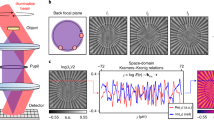Abstract
A holographic method for reconstructing the polarization of light emitted by a photoelastic model is presented. Isochromatic and the entire family of isoclinic fringe patterns may be obtained by examining the holographic image, a posteriori. This is accomplished by using two orthogonally polarized reference beams so arranged that the reconstructed crosstalk images do not overlap. An analysis is preseted crosstalk images do not overlap. An analysis is presented which shows that, to reconstruct polarization, the phase relationship between the two reference beams must be maintained. This requirement is more stringent than that normally required in holography. Experimental verification is presented.
The use of double-exposure holography to obtain isopachic-isochromatic fringe patterns in the reconstructed image is discussed. An analytic treatment of the method is presented. Expressions relating the isopachic-isochromatic fringe pattern in the reconstructed virtual image to the principal stresses are developed. Differences between this analysis and that presented in a recent paper are discussed. Experimental results are obtained and compared to theory and to other experimental results with good agreement.
Similar content being viewed by others
References
Fourney, M. E., “Application of Holography to Photoelasticity”,Experimental Mechanics,8 (1),33–38, (1968).
Nisida, M., andSaito, H., “A New Interferometric Method of Two-dimensional Stress Analysis,”Experimental Mechanics,4 (12),366–376, (1964).
Born, M., andWolf, E., Principles of Optics, Pergamon Press, New York (1965).
Hovanesian, J. D., Brcic, V., andPowell, R. L., “A New Experimental Stress-Optic Method: Stress-Holo-Interferometry,”Experimental Mechanics,8, (8),362–368, (1968).
Mate, K. V., “Two New Applications of Holography to Photoelasticity”, MS Thesis, Univ. of Wash. (1968).
Timoshenko, S., andGoodier, J. N., Theory of Elasticity, McGraw-Hill, New York (1951).
Saad, S., andHendry, A. W., “Stresses in a Deep Beam with Central Concentrated Load”,Experimental Mechanics,1 (6),192–198, (1961).
Lohmann, A. W., Appl. Opt. 4,1667 (1965).
Bryngdahl, O., Jnl. Opt. Soc. Am.,57 545 (1967).
Fourney, M. E., Waggoner, A. P., andMate, K. V., Jnl. Opt. Soc. Am.,58,701 (1968).
Author information
Authors and Affiliations
Additional information
The study reported herein was supported in part by NASA Grant No. NsG-401.
Rights and permissions
About this article
Cite this article
Fourney, M.E., Mate, K.V. Further applications of holography to photoelasticity. Experimental Mechanics 10, 177–186 (1970). https://doi.org/10.1007/BF02324030
Issue Date:
DOI: https://doi.org/10.1007/BF02324030




